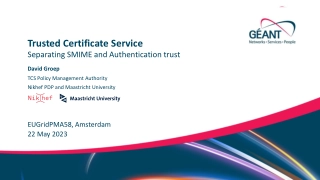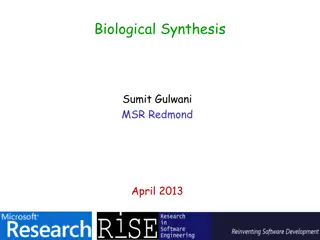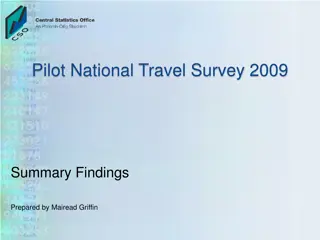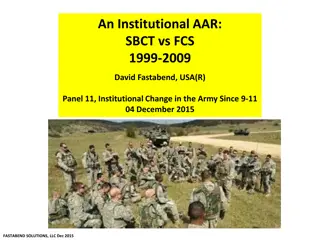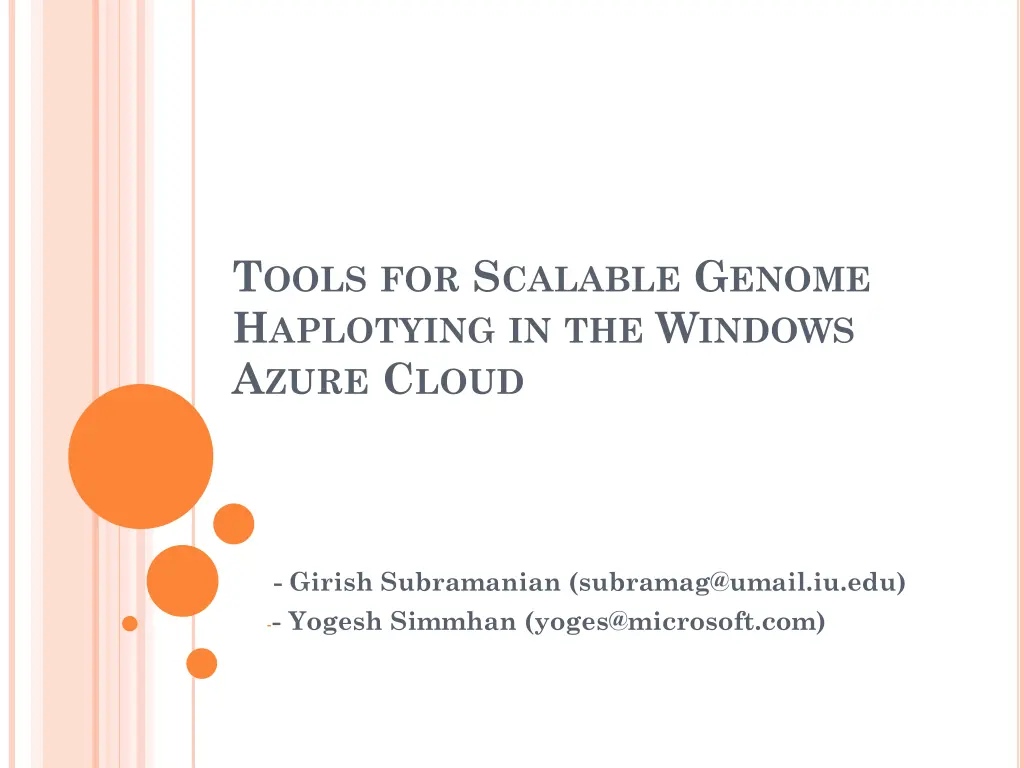
Scalable Genome Haplotyping Tools on Windows Azure Cloud
Discover the HapCUT algorithm for separating haplotypes in genome analysis. Explore how this tool aids in studying human evolutionary history and identifying genetic factors in diseases. Learn about the HAPCUT algorithm's process, including removing non-SNP values, constructing graphs, and converting alleles. See the performance stats and setup details for running tests efficiently.
Download Presentation

Please find below an Image/Link to download the presentation.
The content on the website is provided AS IS for your information and personal use only. It may not be sold, licensed, or shared on other websites without obtaining consent from the author. If you encounter any issues during the download, it is possible that the publisher has removed the file from their server.
You are allowed to download the files provided on this website for personal or commercial use, subject to the condition that they are used lawfully. All files are the property of their respective owners.
The content on the website is provided AS IS for your information and personal use only. It may not be sold, licensed, or shared on other websites without obtaining consent from the author.
E N D
Presentation Transcript
TOOLS FOR SCALABLE GENOME HAPLOTYING IN THE WINDOWS AZURE CLOUD - Girish Subramanian (subramag@umail.iu.edu) -- Yogesh Simmhan (yoges@microsoft.com)
GENOME HAPLOTYPING Goal Separating out the two haplotype chromosome for an individual using their assembled sequence fragments Also known as Phasing Used for making inferences about human evolutionary history Find out genetic factors of diseases among individual Phasing algorithm We use the HapCUT algorithm which uses the graph MaxCut algorithm to separate the two haplotypes.
HAPCUT ALGORITHM Sequenced Fragments for each chromosome ACTCAC-----GTATGGTG ACGCAC-----GTATCGTGC TATCGTGC-----ACACTCT ACTCAC--------------------ACAGTCT ACGCA----------------------------------------------------------AGCGTTA GAAGAT---AGCATT 1. Remove Non SNP values 2. Remove Consistent values 3. Remove Fragments which have less than 2 alleles --T------------G--- --G------------C---- ---C------------C--- --T--------------------------G--- --G---------------------------------------------------------------G--- --A--------A-- 1. Compare the Fragments with the consensus fragment and convert it into bits (1 or 0) 2. Construct a graph for the fragments spanning the SNP locations 3. Apply MaxCUT 4. Convert the bits back to alleles. ------T------------G------------G--------------A---------A----- ------G------------C------------C--------------T---------G----- The two separate haplotypes.
HAPCUT ALGORITHM DoInitialize TrimSparseFragmen ts SplitSparseContig For each contig ContigToFr agment ContigToFr agment DoHapCut DoHapCut HaplotypesF romFragme nt HaplotypesF romFragme nt TestHaplotype Match TestHaplotype Match MergeHaplotypes
BIO.NETAND HAPCUT ALGORITHM Main data structures Contig Contig.AssembledSequence SparseSequence Parsers and Formatters ISnpReader , BufferedSnpReader read the SNP XsvContigFormatter/Parser serialize/deserialize each chromosome XsvSparseFormatter/Parser serialize/deserialize each SparseSequence reference file
TIMETAKENINLOCALMACHINE 2:52:48 Cummulative total time for each chromosome 2:24:00 1:55:12 hours HapCut Time Split Time 1:26:24 Trim Time DoInit Time Deserialize Time 0:57:36 0:28:48 Chromosome # 0:00:00 13 14 15 16 17 18 19 20 21 22 The performance numbers are baseline numbers. The tests were run on a Windows Vista 32bit/2.2GHz dual-core (only single used for this)/4GB RAM/4MB L2 Cache. The longest chromosome 13 required 116 MB to store in the disk. All chromosome took less than 2GB of virtual memory
WHY DISTRIBUTED COMPUTING? Scalable for large number of individual on all 22 chromosomes. Embarrassingly parallel algorithm. Reasonably small data size data can be moved to remote resource. Can be made available as service. Distributed Computing choices : Windows Azure DryadLINQ Windows HPC
BASIC ARCHITECTUREOFAZURE APPLICATION Web Role Instances Worker Role Instances Load Balancer Windows Azure Fabric Tables Blobs Compute Storage Queues d e f b a Fabric c
BASIC ARCHITECTUREOFAZURE APPLICATION (CONTD.) Web Role Web application can be accessed by http/https from the public network Worker Role Background processes which do not expose public endpoints Can only communicate through storage services Storage Services Queue for communicating messages between the roles Blobs for storing unstructured data (files) Tables for storing named value(s) pairs in (non relational) tables All the storage services can be accessed from the public network using REST interface.
TECHNICAL SPECSOF AZUREINSTANCES Each worker role or web role instance runs on a separate Virtual Machine. Each Web role instance and Worker role instance has its own dedicated processor core. Workers having different roles can run different code bases (applications) Each instance has 250 GB of local disk. Each instance has1.5-1.7GHZ AMD processor and runs Windows 2008 Server x64 with 1.7 GB RAM. Instances (Virtual Machines) are transient.
FAULT TOLERANCE All data is replicated at least 3 times Replicas are geographically spread out. All of Storage (Blobs, Tables and Queues) is built on this replication layer Efficient Failover Data served immediately from available replicas located elsewhere in the data centre Dynamic replication to maintain a healthy number of replicas Recover from a lost/unresponsive Drive or Node Recover from data bit rot
AVAILABILITY AND SCALABILITY Automatic Load Balancing of Hot Data Monitor the usage patterns and load balance access to Blob Containers, Table Partitions and Queues Distribute access to the hot data over the data center according to traffic Caching of Hot Blobs, Entities and Queues Hot Blobs are cached to scale out access to them Hot Entity and Queue data pages are cached and served from memory
WHY REQUIRED ? Deploying existing application to cloud requires writing wrapper code. Adding new worker role for each application is a management challenge. Clients have to use Azure Queues to communicate with applications. Porting non .Net windows applications is a challenge.
DLL , EXE, MATLA B, JAR files. Azure Blob Storage Application Binaries Register Azure Table Storage Registry Tables 2. Get the application information . 3. Download the application binaries 4 .Unbind the input parameter. 5.Start execution. Azure Workers 6. Bind the output parameters. 7. Put the result item in result Queue 1. Azure Worker gets the work item from the work queue
GENERIC FRAMEWORKARCHITECTURE. In order to build such a framework , we require : Registry Tables To store the application information such as application binaries required, their location, etc. Input parameter required by these application. Application s output information Generic Worker We need generic workers that will download the required application binaries from registry and starting the application execution. Thus providing an elasticity across various application.
GENERIC FRAMEWORKAND HAPCUT We deployed 10 worker roles in Azure and used the Generic Framework to deploy the HapCut application. Each worker works on an individual chromosome. Time taken to phase 10 chromosome is equal to the time taken by the longest ones.
THANKYOU Questions ?

